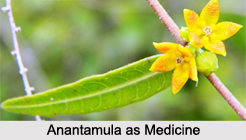 Anantamula has botanical name of Hemidesmus indicus. In Ayurveda system of medicine, it is widely used in the treatment of oligospermia, gastritis, anorexia, menorrhagia etc. Ayurvedic practitioners call it "Sugandi" and have used the herb for about 1,000 years. The roots of these plants are said to be sweet, demulcent, alterative and useful in loss of appetite, disinclination for food, fever, skin diseases, syphilis and leucorrhoea.
Anantamula has botanical name of Hemidesmus indicus. In Ayurveda system of medicine, it is widely used in the treatment of oligospermia, gastritis, anorexia, menorrhagia etc. Ayurvedic practitioners call it "Sugandi" and have used the herb for about 1,000 years. The roots of these plants are said to be sweet, demulcent, alterative and useful in loss of appetite, disinclination for food, fever, skin diseases, syphilis and leucorrhoea.
Dose of Anantamula in Medicine
They are generally used in combination with a number of other medicines. The following are a few illustrations. Take anantamula, root of Pavonia Odorata (bala), tubers of Cyperus rotundus (mustaka), ginger and the root of Picrorrhiza kurroa (katuki), equal parts in all 2 tolas and reduce them to a paste with water. This dose administered with warm water in the morning, is said to clear the bowels and relieve fever.
A decoction of the roots of colocynth, anantamula, sariva and Hedyotis biflora (parparta), prepared in the usual way, is administered with the addition of powdered long pepper and bdellium in chronic skin diseases, syphilis, elephantiasis, loss of sensation and hemiplegia.
This article is a stub. You can enrich by adding more information to it. Send your Write Up to content@indianetzone.com
Related Articles
Ayurveda
Origin of Ayurveda
Ayurveda Medication
Elements of Ayurveda
Concepts of Ayurveda
Ancient Literature of Ayurveda
Sushruta Samhita
Classification of Medicine




















